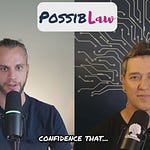Breathe. Focus. Move forward. That’s the simple frame
offered on my PossibLaw podcast this week when we talked about tackling hard things. He reminded me: it’s not life or death; there’s no tiger in the bushes. Most of what feels scary at work is simply unfamiliar, not fatal.That distinction matters right now, especially in the age of AI and in the legal industry. Change is accelerating. How we research, draft, review, and deliver legal services is shifting under our feet. It is hard. And it’s also the exact kind of hard that makes us better.
Its time for legal professionals to get past the fear, and embrace the future. Its time to choose the hard thing on purpose, remind ourselves we have been augmented professionals for decades and there is a practical playbook for doing it without panic.
Picture this: whether your a law firm attorney or paralegal or an in-house legal professional, every single day you are feeling overwhelmed with the endless docket of requests for your domaine expertise. Meanwhile every headline says AI will reinvent your job by Tuesday. Your heart rate spikes and palms sweat.
We confuse difficulty with danger. Hard is not hazardous. Hard is how you grow range. In law and in life, the “do hard things” muscle is the only one that compounds. It is also how we model steadiness for colleagues, clients, and yes, the next generation of lawyers who are watching to see whether we panic or lead. So what do you do?
Breathe. Focus. Move forward. Once upon a time finding a legal case meant going to a library and digging into books. You figured out how to master that technology. Then came e-discovery and platforms like Relativity. No problem, you overcame and embraced. Productivity software got added to your requirements along with back end billing and management tools. No big deal, you hunkered down and learned. So why is AI different? It’s not. Embrace the hard thing, embrace the future and shape what’s next.
The Real Constraint Is Not Skill. It Is Story.
Most firms have the skill to learn new tools. They lack the story that makes change feel survivable. Our invisible constraints are narratives like “If I do this wrong, I break privilege,” or “If I get faster, I kill my billables,” or “If I ask for help, I look junior.” Those stories create friction long before any integration or training does.
Here is the reframe I want legal professionals to take in moments that feel existential. Name the work as a hard thing, not a mortal threat. When it is not life or death, your brain reenters the conversation. Breathing returns. Priorities snap into focus. You execute.
Work Backward from the End State
End state: trustworthy legal services that are faster, cheaper, and more humane to deliver. That is the promise of AI if we decide, design, and deliver with intention.
Leverage: reusable data, repeatable workflows, and a culture of small experiments.
Incentives: align outcomes so the people who make good choices win, reputationally and economically.
Friction: shrink the number of steps between a lawyer’s question and a reliable answer, while embracing friction in the right places.
Ego: give people a way to keep status while they learn in public.
When you organize around these levers, “AI” stops being a mystery project and becomes process improvement with new power tools.
A Scene I Keep Seeing
A mid-size litigation team meets to “figure out AI.” The agenda drifts, tension rises, and someone jokes that we should wait until “the dust settles.” Translation: we are overwhelmed, so we will stall. I ask one question: What would a good week look like if AI helped? Silence, then clarity.
New matter intake gets triaged in minutes, not hours.
First drafts arrive as structured outlines that reflect firm templates.
Privilege screens run by default.
Partners see risk flags without hunting through email.
Now the game is concrete. We are not debating the future of law. We are deciding how to make next week easier.
Two Mini-Cases
1) In-house legal ops builds an AI intake triage.
The team cataloged their top 20 recurring requests, wrote plain-language decision trees, and connected the trees to an internal chat interface. Results in month one: fewer fire drills, clearer handoffs, and a growing knowledge base. What changed the culture was not the model. It was the rule that no one could reject a draft without suggesting a better one. That reduced ego friction and turned critique into coaching.
2) A boutique employment firm rewrites the billable story.
Partners worried that efficiency would punish them. They switched to blended fees on repeatable work, then published “quality gates” that defined where humans must review. Associates used AI to produce issue maps and citations, then lawyers applied judgment. Revenue held, client satisfaction rose, and attorney stress dropped because “done” became a visible milestone. Incentives finally matched the behavior they wanted.
Why This Matters Now
AI will not replace lawyers who can breathe, focus, and move. It will replace the hours we used to waste proving we were busy. That is good news if we redirect time toward higher-order lawyering: pattern recognition, negotiation, counseling, and strategy. The industry shift is the hard thing in front of us. Our job is to make the right thing easy.
Here are the common blockers I see:
Approval labyrinths that turn a one-hour pilot into a six-month saga.
Ownership gaps where everyone wants input and no one wants accountability.
Tool sprawl that creates ten places to look and zero places to trust.
Status anxiety that confuses “I do not know yet” with weakness.
None of these are technical. They are human. Name them so you can design around them.
A Simple Operating Rhythm
Use this weekly loop to build “hard-thing reps” without drama.
Pick one friction. Choose a single choke point you can measure, like intake time or first-draft latency.
Define the end state. Write the two-sentence “good week” description. If you cannot write it, you cannot ship it.
Pilot with constraints. One team, one matter type, two weeks. No committees.
Set quality gates. Where must a lawyer review, sign, or escalate. Publish it.
Close the loop. Capture what worked, update the template, share the win. Repeat.
Strategy → execution → outcomes. Decide, design, deliver.
The Coaching Close
Doing hard things is not theater. It is a quiet habit. When the pace of change spikes, your nervous system screams that the stakes are fatal. They are not. As Alex Boyd reminds us, there is no tiger. So:
Breathe. Enough oxygen for your brain to come back online.
Focus. One friction, one end state, one pilot.
Move. Ship something small that improves a real week for a real team.
That is how you amplify impact in the age of AI. Not by waiting for certainty, but by modeling calm execution when it counts. Hard things are not where excellence goes to die. Hard things are where excellence is built.
Thanks for reading & listening to PossibLaw. We hope you learned something actionable that will help you grow your mind and career. If you enjoyed today’s content please share it. Thank you!









